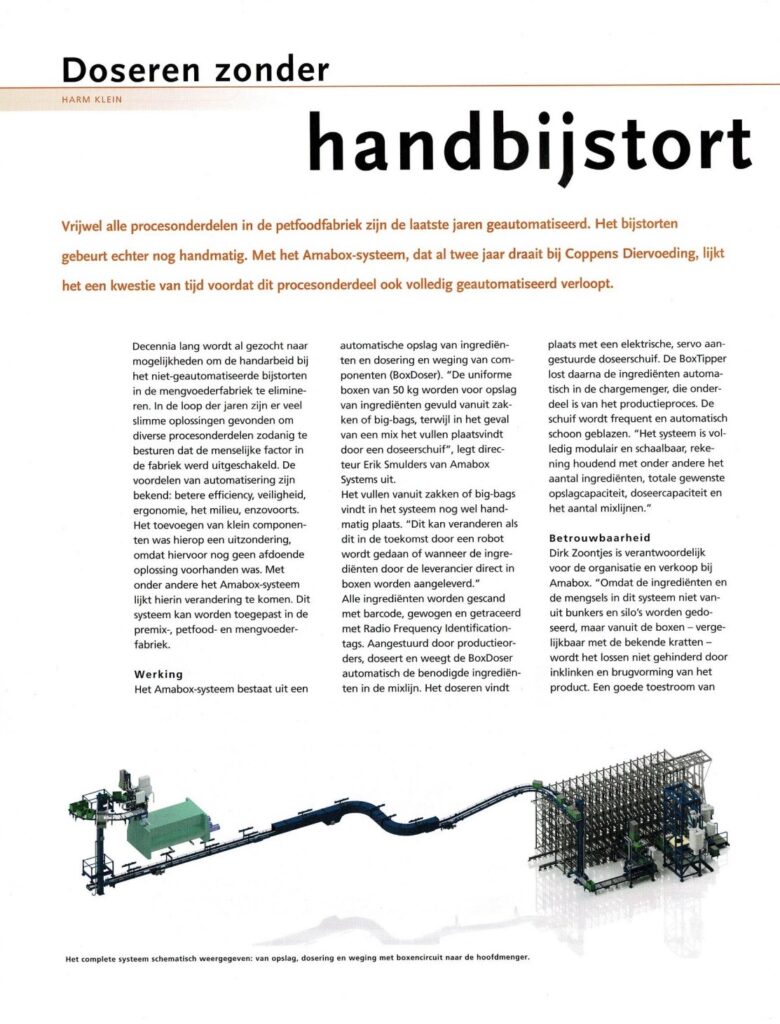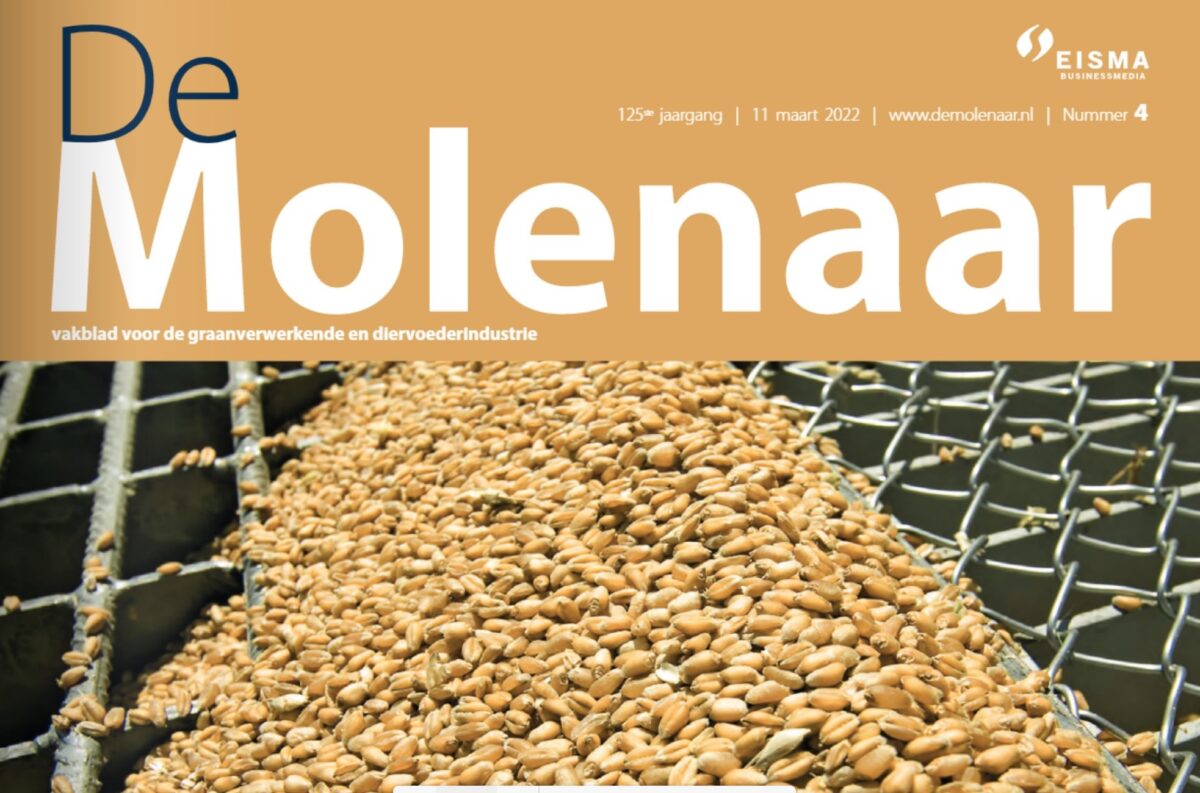Will manual ingredient handling disappear?
AMABOX shows that it is possible
For decades, people have been looking for ways to eliminate manual labor in this non-automated process part in the compound feed factory.
Over the years, many smart solutions have been found to control other process components in such a way that the human factor in the factory was eliminated. We know the advantages: better for efficiency, safety, ergonomics, the environment, etc. The addition of small components was an exception to this, because no adequate solution was available yet.
This now seems to be changing, see also the innovation offered by AMABOX, which is mentioned in this article. The system can be applied in the premix factory, pet food factory and compound feed factory.
We are talking to Erik Smulders, CEO, and Dirk Zoontjes, responsible for the organization and sales at AMABOX.
Operation
Erik explains how it works: “The ‘AMABOX System’ consists of an automatic storage of ingredients (AmaStore) and dosing and weighing of components (BoxDoser). The 50 kg uniform boxes are filled from bags or big-bags for the storage of ingredients, while in the case of a mix, the filling takes place through a dosing slide.
The filling from bags or big-bags still takes place manually in the system; this may change if this can be done by a robot in the future or if the ingredients are delivered directly in boxes by the supplier.
All ingredients are barcoded, weighed and tracked with RFID (Radio Frequency Identification) tags. Controlled by production orders, the BoxDoser automatically doses and weighs the required ingredients in the mix line. Dosing takes place with an electric, servo-controlled dosing slide. The BoxTipper then automatically discharges the ingredients into the batch mixer, which is part of the production process. Dosing slide is frequently and automatically blown clean.
The system is fully modular and scalable, taking into account the number of ingredients, total desired storage capacity, dosing capacity and the number of mixing lines.”


Reliability
Dirk adds: “Because the ingredients and mixtures in this system are not dosed from bunkers and silos, but from the boxes – comparable to the well-known crates – the unloading is not hindered by settling and bridging of the product. This guarantees a good influx of the product. The automation includes a learning system; in this case no product learning, but a machine learning system. Any previously observed deviations in dosage and weighing are calculated in the following batches. In addition, check weighing prevents any errors.
Dosing wrong ingredients is almost impossible, because the human factor is switched off.
To prevent dust nuisance, dust extraction has been installed at a number of critical points. The amount of dust extracted is only about 1‰.”
Coppens Diervoeding
Erik: “The first user of the system is Coppens Diervoeding in Helmond, where we have gained two years of experience. The system, which is installed in an adjacent warehouse next to the factory, consists of a large computer-controlled rack with 500 boxes. In the past, there were thousands of manual additions per week of premixes, additives and minerals. The ingredients are now accurately dosed and weighed to the nearest two grams during the production process of the feeds. The boxes are transported via a roller conveyor to the floor above the main mixer, tilted, unloaded and returned empty to the filling station.
Ofcourse, there were some teething problems in an installation like this, but they have all been resolved. Coppens is satisfied and future customers are welcome here to see the ‘AMABOX System’ work in practice.”
Higher efficiency
Erik explains that in practice this automation can easily yield a 10% cost reduction. “The fact that there is no operator involved who has to carry out the addition, but that the boxes are immediately ready to add the mix into the mixer in a very short time, means that the cycle time of the grinding-mixing line is considerably shortened. In many cases by 20%. Just imagine: no more addition of the individual ingredients, no more waiting for the operator who is busy with other activities, no more supply and removal of bags in the factory and no more waiting times because ingredients are not available.
The box with the mixture, which has already been filled ‘shortly or long’ in advance, is ready for addition to the mixer.
Ofcourse, the system does require an investment, but we can demonstrate that it quickly pays off, even if the amount of small ingredient tipping is limited.
Another positive development is that the man/woman from the control room is no longer burdened with the dusty and unhealthy dumping of the powders. The operator in 2022 – often with a higher education – is no longer ‘eager’ to perform this action 10 times an hour.”
Small organization
Erik explains that the company was founded with the aim of finding an answer to the worldwide growing demand for solutions in this field. “We realized that we can work most effectively in a small organization, within which solutions can be found creatively. As a small team, we are very familiar with the problems in production companies and are familiar with the environmental and logistical puzzles surrounding manual small ingredient handling. Numerous systems are already available for the dosing of medium-sized and large raw materials; it is up to us to find a tailor-made solution for the small components for every practical case.
Our product is already in high demand: orders and serious interest worldwide.
Several installations are currently being prepared for premix and pet food producers in our recently equipped test room for AMABOX in Reusel.”
With sobriety from Brabant, Erik and Dirk summarize the advantages once again and are delighted to present this automation system to potential new customers. “It finally shows that it is quite possible to offer an alternative to manual handling in the factory, which has so many disadvantages.”
With its (new) assembly facilities and office, AMABOX is located in Bladel with a temporary test center in Reusel.
The components of the ‘AMABOX System’ are manufactured and supplied by individually selected suppliers. The development and engineering, as well as testing before delivery, takes place in-house.
This article appears in De Molenaar. Visit them on www.demolenaar.nl.
For regular updates, follow us on LinkedIn or see our updates page.

